 |
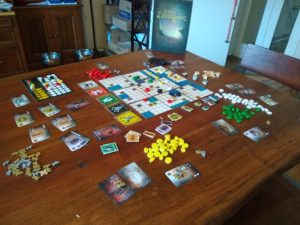 |
5) The Great Zimbabwe (2012): Popular culture in general, and board games in particular, seem to often forget that Africa is an amazing place with a unique history that began long before European colonization. The Great Zimbabwe is one of the rare games that bring the player into the mythology of that world. The gameplay itself requires players to create an economic system where goods need to be transported around the map so that monuments can be raised to the gods, each of which gives a player a powerful ability. Figuring out how to exploit that ability and the network the other players build is the heart of the game. The unique way money moves through the game throws a large wrench into those plans, as does the ever-changing board, where new resources and connections can be created by any player willing to pay the price. The tight scoring makes it appear that every match is extremely, close where anyone could have won. This, along with the generous way wealth is distributed, gives the game a friendly veneer over the cutthroat economic battle where a single cattle often decides the game.
 |
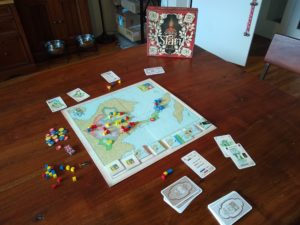 |
4) King of Siam (2007): 8 moves. That’s all you get to do in this game. You can play each of your 8 cards once. Some turns you won’t do anything. Some turns you might do 5 things. Trying to figure out when shouldn’t be too hard either. The game has no luck elements. You can look at the board and see how the entire game will unfold. After each player has the chance to play cards, one area is scored and all of the cubes on that area are taken off the board. Playing cards means the player has fewer resources to respond to their opponent, so no one really wants to play any, but it is always the case that if no one does anything, one side will win, so the other player has to do something. Each move can drastically change the course of the game, and with two completely different victory conditions to worry about, players need to be able to constantly reassess the flow over the game after every move and have the insight and creativity to find moves that will push the game in their favor. In addition to this deep, strategic gameplay, King of Siam plays completely differently at its different player counts. The two-player game feels like a traditional match of wits, the three-player game is a chaotic battle of leverage, and the four-player game is played in partnerships, testing both your ability to read the board and your talent at reading your teammate and working together as a cohesive unit. Topped off with a setting not usually seen in board games, King of Siam is an amazing strategy game that puts unique limitations on the players to ensure every move counts.
 |
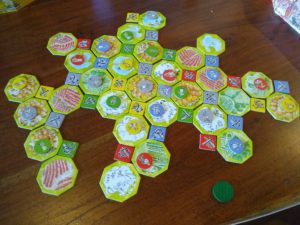 |
3) Keythedral (2002): Richard and Juliet Breeze make some of the nicest looking games. I don’t mean they look attractive, though they certainly do. I mean the games have a relaxing atmosphere to them and appear like they will be light, friendly affairs with no direct conflict and players just doing their own thing trying to get the high score. Keythedral looks like that, with each player getting 5 cute cottages to place in a grid of fields where resources can be collected. Each turn they send out their workers to collect resources, which in turn they use to make upgrades and build up the game’s titular Keythedral for points. Unfortunately, one problem becomes apparent on the very first turn. All of the cottages are part of the same grid, and because of this many will be neighbors. These neighbors all want the same resource, and even though this game looks very kind, there is no sharing. Very quickly the kind facade breaks, with fences being built and torn down, cottages upgraded into houses to send out more workers, and bribes paid to manipulate the turn order to get to the fields first. Fail to do this and you will find yourself unable to place your workers, as all of the fields are filled with the whimsical pastel tokens of the other players. A lot of yelling tends to happen while playing Keythedral. Whoever positions their cottages best and manages the ensuing chaos will come out on top of everyone else, and hopefully there will be no hard feelings over all of the workers left unplaced. Because in the end, even though this game is a vicious back and forth where you can only get ahead by denying your opponents, it’s a beautiful game that was only fun because you all played together. Of all the games on this list, none of them have made me laugh (and scream) more than this one.
 |
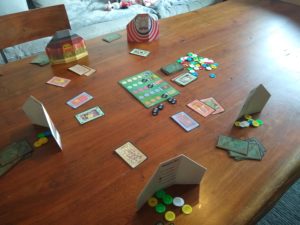 |
2) Modern Art (1992): Art is on its face worthless. Anyone can make something and call it art, but no one has to pay them for it. The value from art doesn’t necessarily come from the quality of the work, but instead from the perceived popularity of the artist. In Modern Art, the quality of the paintings doesn’t matter, all that matters is how hot the artist who made it is. Any given card can be completely worthless, but players are forced to speculate on them anyway, as they can’t afford to give another player a valuable card at a low price. The cards being sold don’t come out randomly, though. Each turn a player picks which artist to sell, giving them both the chance to make money and control how much each artist’s works will be each round. But that decision is difficult, as your selection of paintings is limited, and an artist that manages to stay hot for multiple rounds will see their paintings potential value skyrocket. Ending a round gives you the final say in an artist’s value, but the player who ends the round loses the chance to sell a card. Picking which cards to buy is no easy task either, as a player has only limited control over the card’s value. Pitfalls abound as taking multiple cards of the same artist might cause people to stop playing them lest your investment appreciate too much. Complicating things even more is that there are four different kinds of auctions, some of which will make your plans more difficult than others. This is a game of subtle choices, where sometimes small $1 gains stack up to a close victory, and other times tragedies strike when two cards that cost you $100 end up worthless, sinking all of your hard work. Reiner Knizia has made many excellent auctioning games, but Modern Art is the clear masterpiece of the genre.
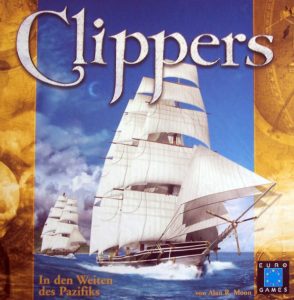 |
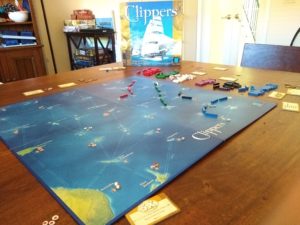 |
1) Clippers (2002): This game has an extremely blue board that seems lonely. Massive amounts of empty space belies the fact that players will be tossed together into a whirlpool interaction. Each player invests in the various islands throughout the board, profiting when different shipping lines reach them. The rubs here are that multiple players will often be invested in the same island, and that any player can expand any shipping line. This forces players to make difficult decisions on where to expand and where to invest. Wise placements can make you allies as you work together raising the value of your mutual investment, but redirecting lines so that your opponents can’t profit from their biggest investments is just as important. Each turn, players choose how much control they have over the expansion of the board, but the less power they take the more they can potentially profit. This constant shifting of goals and control makes for a dizzying balancing act, but the extremely simple rules keep the experience easy and accessible. This game has so many elements I love: emerging alliances, player control of board development, varying game flow, a tug of war over shared resources, investments, difficult choices, and extremely interactive gameplay. No title will ever cover the complete range of experiences games can bring, which is why this list has 25 titles, not just one. That said, Clippers hits so many great notes, and even though it really only works with 5 players, it has an eternal space in my collection.
